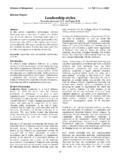Transcription of Vision: The relationship between a firm’s strategy and ...
1 Journal of Behavioral Studies in Business vision : The relationship between a firm's strategy and business model Boniface C. Madu Grand Canyon University ABSTRACT. Leadership and management in all organizations face the problem of choosing among alternatives, and thinking strategically about their company's present circumstances and future prospects. This paper synthesizes strategic vision , analyzing and evaluating the relationship between business model and strategy and provides justification how both concepts can create advantages for the customer and the organization. As business environments become increasingly complex and continuously changing at very fast pace, the strategic management process is applied by most organizations to make the internal and external environments more manageable. While a company's business model is not the same as its strategy , closely related to the concept of strategy is the concept of the company's business model.
2 A company's business model relates to how and why a company's product and offerings can generate attractive revenues and still create value for the customers. Business models convert new innovation to economic value for the firm and the customer. Crafting strategy sets the course, direction, objectives and performance capabilities for implementing and actualizing a chosen strategic outcome. An organization formulates a strategy to establish a difference in the market and to out perform rivals. Both strategy and business model are articulated through a strong vision . This paper suggests promoting more research and awareness in the area of business model. Keywords: Business model, Leadership, Management, Organization, strategy , vision . Copyright statement: Authors retain the copyright to the manuscripts published in AABRI.
3 Journals. Please see the AABRI Copyright Policy at vision : The relationship , page 1. Journal of Behavioral Studies in Business WHY vision . vision in its simplest concept means seeing the future today. Nanus, (1992) defines vision as realistic, credible, attractive future for an organization. A realistic vision therefore must be relevant to the organization to be credible. A vision must inspire and motivate those who are to implement it in the organization. It must be seen by the staff as realistic, honest and achievable. It must be attractive. A vision is meant to inspire the leader and the organization to look into the future prospects of the organization. A vision is not in the present or where you are now, a vision is where you will be in the future. Strategic vision is the first step in formulating and implementing strategy .
4 A company's strategic vision provides the logical reason for future plans and directions of the company, and aims the organization in a particular direction, providing a strategic direction for the organization to follow in the aspirations of shareholders in the long run. The vision must be definite about how the organization leaders intend to position the organization beyond where it is presently. According to Westley & Mintzbery (1989) Strategic visionaries are leaders who use their familiarity with the issues as a spring board to innovate, who are able to add value by building new perceptions of old practice (p19). Westley and Mintzberg statement offers a deeper meaning of strategic vision for the use of past knowledge as a spring board to innovate and formulate synergies that create new practices. Strategic visionaries use the knowledge of their environment to innovate.
5 Firms with a good knowledge of their environment remedy environmental problems associated with their products and services. Visionary organizations are capable of leading change, when the leaders realize that their visions of the future are not firmly fixed and remain flexible to accommodate change. A company's strategy should be a blend of proactive actions on the part of leaders to improve the company's market position and financial position and reactions to anticipated developments and fresh market conditions, Thompson, Strickland & Gamble (2005). Consequently, a bigger portion of a company's current strategy flows from managements past actions and business approaches that are working well and new managerial initiatives are added to strengthen the company's overall position and performance. An important part of visionary leadership therefore, is prudence; monitoring change, making the necessary mid-course corrections, and knowing when to initiate a new vision forming process Nanus, (1992).
6 The inference is that a company's strategy emerges incrementally and evolves over time. Changes in the external environment may force management to adjust certain strategic variables in response to unfolding events. When fine tuning the existing strategy is not enough, major strategic changes are required, such as when strategy is failing or when new and better opportunities arise. Nothing could be more common in organizations than a vision that has over stayed its welcome Nanus, (1992). There is no schedule for the revision of a vision as long as it appears to be working and is consistent with the development in the internal and external environment of the organization. However, there may be times when the internal and external environments threaten the existence of the organization. As when an organization is reoriented by changes beyond its control or when rapid changes in technology continue to orchestrate frequent reviews of company vision inline with new technological innovations.
7 When these situations arise, it may be time to review and reverse the vision plan and strategy in line with these changes. In these circumstances, a company's management must battle with the issues of what direction the company should take to improve its current market position and future prospects. Deciding to commit the company to one direction versus another must be carefully analyzed to vision : The relationship , page 2. Journal of Behavioral Studies in Business draw a reasoned conclusion on why advancing in the chosen direction makes a good business sense for the organization Thompson, Strickland & Gamble, (2005). A strategic vision as a road map should show the route a company intends to take in developing and strengthening its business, and should paint a picture of a company's destination and provide a logical reason for going there; Thompson, Strickland & Gamble, (2005).
8 A vision must therefore be specific to a particular company and must be definite on how the company leaders intend to position the company beyond where it is presently. A well articulated strategic vision communicates management's goals to the shareholders and helps to steer the energies of the company in a particular direction. Thompson, Strickland & Gamble, (2005) asserts that a good vision needs to be a bit beyond the reach of the company, but progress towards the vision is what unifies the efforts of the company. One way to assure that vision formation is a unifying process is to spread the leadership role throughout the company at every level, so that every unit is encouraged to develop its own vision . To this end Kotter, (1996) determines that a well worded vision statement should be graphic, directional, focused, flexible, feasible, durable and easy to communicate.
9 Graphic painting a picture of the kind of company that management intends to create, and the market position the company is vying for. Directional Stating the company's destination and shows the kind of business and strategic changes that may be forth coming. Focused Be specific to provide managers with guidance in making decisions and allotting resources. Flexible A well stated vision must be capable of change, as the company's future operations change to accommodate unfolding circumstances. Durable It must appeal to the long term interest of shareholders. Easy to communicate It must be to explain. While strategic vision is concerned with where we are going and why it is good to go there, a company mission statement deals with the present business scope and purpose. Who are we, what do we do, and why we are here Thompson, Strickland & Gamble, (2005).
10 A company's mission defines the segment of customers the company seeks to satisfy, the market segment it seeks to serve, and the resources deployed to achieve the purpose, Thompson, Strickland &. Gamble, (2005). If a company's mission is to have any managerial value, or reveal anything useful about its business, it must direct attention to the particular market segment in which it operates; the buyer needs it seeks to satisfy, the customer groups, the market segment it is trying to serve and the types of resources it is deploying to please this group of customers. An effectively worded mission statement typically describes the company's present business scope and purpose. In our definition of vision , we related an organization's vision to its mission and values. The vision must be related to the values of the company, which represents an embodiment of the company.

















